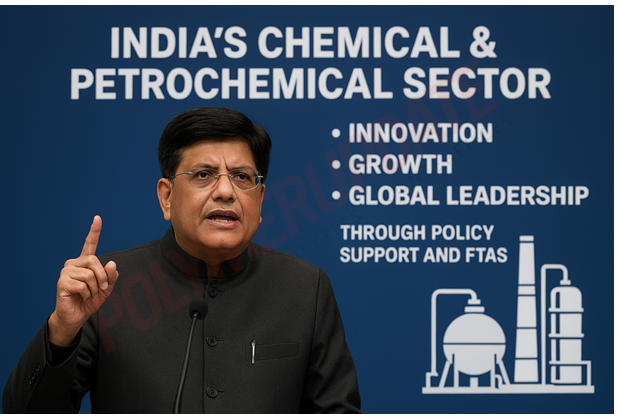Union Minister of Commerce and Industry Piyush Goyal said the chemical and petrochemical industry holds immense potential to spearhead new technological developments and position India as a global leader in delivering cutting-edge solutions for the economy and industry. He was speaking at the 7th Indian Chemicals and Petrochemicals Conference organised by the Confederation of Indian Industry (CII).
 To realise this growth potential, the government has drafted industry-friendly policies designed to support all participants across the chemical and petrochemical value chain, he added. These policies aim to ensure balanced growth that benefits all sections of society, strengthens the domestic economy, and enhances India’s position on the global stage.
To realise this growth potential, the government has drafted industry-friendly policies designed to support all participants across the chemical and petrochemical value chain, he added. These policies aim to ensure balanced growth that benefits all sections of society, strengthens the domestic economy, and enhances India’s position on the global stage.
“Great and advanced nations achieve their status through a focus on technology and innovation, and India must follow this path to attain its developmental goals. Even oil-rich countries are investing in value-added products, clean energy, renewable energy, and climate change-related technologies, reflecting the global shift towards innovation-driven growth,” Goyal emphasised.
Robust economic growth
According to the International Monetary Fund (IMF), India’s economic growth is projected at 6.6 percent in 2025 and 6.2 percent in 2026, the agency said in its periodic report titled World Economic Outlook (WEO) released earlier this week. Compared with the July WEO Update, this marks an upward revision for 2025, as the strong carryover from a robust first quarter more than offsets the impact of the higher U.S. effective tariff rate on imports from India imposed since July. However, the forecast for 2026 has been revised downward. Compared with the pre-tariff forecast in October 2024, growth is now projected to be cumulatively 0.2 percentage point lower.
Global growth is projected to decelerate from 3.3 percent in 2024 to 3.2 percent in 2025 and further to 3.1 percent in 2026. On a fourth-quarter-to-fourth-quarter basis, growth is expected to slow from 3.6 percent in 2024 to 2.6 percent in 2025, before recovering to 3.3 percent in 2026. At market exchange rates, world output is forecast to expand by 2.6 percent in both 2025 and 2026, compared with 2.8 percent in 2024.
The growth forecast remains largely unchanged from the July 2025 WEO Update, reflecting gradual adaptation to trade tensions, but it remains well below the pre-pandemic average of 3.7 percent. Sequential growth from the second half of 2025 into 2026 offers a clearer picture by removing distortions caused by front-loading in early 2025: the global economy is projected to grow at an annualized average rate of 3.0 percent over these six quarters — a slowdown of 0.6 percentage point from the 3.6 percent average rate recorded in 2024.
The forecast for 2025–26 is also lower, by a cumulative 0.2 percentage point, than projected in the October 2024 WEO, prior to major policy shifts in key economies. Union Minister Piyush Goyal said the IMF’s upward revision of India’s growth outlook is evidence of the country’s economic resilience and strong fundamentals. The upgrade comes at a time when the global economy faces fluctuations, yet the need to tackle climate change and advance technologically remains constant. Science, research and development, and innovation, he said, play a pivotal role in sustaining India’s robust economic growth and will continue to serve as the backbone of the nation’s journey toward becoming an advanced economy and achieving the vision of Viksit Bharat by 2047.
Strategic role
The chemical and petrochemical sector holds significant potential and plays a strategic role in the nation’s overall development. It has wide-ranging applications and influence across multiple industries, including agriculture, healthcare, infrastructure, construction, energy, and mobility. The sector’s products and services are ubiquitous, directly or indirectly impacting almost every aspect of the manufacturing and consumption ecosystem.
Industry leaders must carefully assess their strengths and identify areas where India can build a global competitive advantage. The sector should aim for leadership in international trade by increasing India’s share in global exports and moving beyond its current modest contribution. Strengthening supply chain resilience and diversification is also critical, as reliance on a single supplier or a limited number of countries can create vulnerabilities.
While certain products may require domestic protection to ensure self-reliance and secure supply chains, the sector must otherwise remain integrated with global markets to enhance efficiency, competitiveness, and sustainable growth. For India’s strategic approach to global integration to succeed, domestic industries must remain competitive. To become an advanced economy, India needs to engage actively with international markets, explore trade opportunities, and attract investment—while maintaining a careful balance between global integration and domestic industry protection.
Focus on trade agreements
Goyal outlined the government’s consistent focus on negotiating free trade agreements (FTAs) and expanding India’s global trade footprint. He noted that several agreements have been concluded with multiple countries and regions, including Mauritius, the UAE, Australia, Liechtenstein, Norway, Iceland, Switzerland, and the United Kingdom. These trade engagements, he said, are designed to open new markets for Indian products, attract technology and investment, and foster collaboration in innovation-driven sectors, while ensuring that domestic industries are not exposed to undue risks.
India’s objective, he emphasised, is to strike a delicate balance—enabling domestic businesses to compete internationally, promoting exports, and simultaneously protecting domestic production and safeguarding the interests of 140 crore consumers. While the government continues to pursue global integration, it remains attentive to market dynamics, supply chain resilience, and the need to ensure fair and sustainable trade practices that benefit both industry and consumers.
Goyal urged industry participants to work collaboratively, support one another across value chains, and raise concerns related to predatory pricing, dumping, or non-tariff barriers that hinder exports. He assured that the government would provide timely interventions and remedies to protect industry interests, and encouraged stakeholders to suggest measures for simplifying procedures, reducing compliance burdens, and decriminalising minor offences to enhance the ease of doing business and promote innovation.
DILIP KUMAR JHA
Editor
dilip.jha@polymerupdate.com
